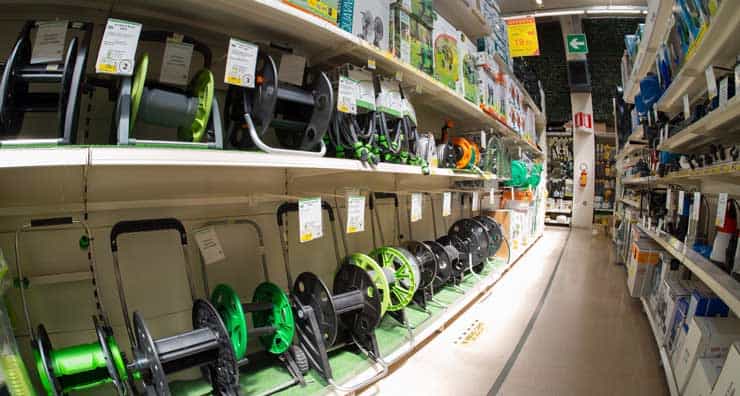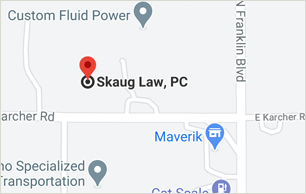Retail Store Negligence | Were you injured in a Retail Department Store?
Last updated Thursday, June 29th, 2023

Retail Store Negligence is when controllable circumstances were ignored and a patron of a business is injured. Slip and Fall accidents are the most common retail negligence causes but there are others.
Most of the time we feel safe when we are out and about running our errands and entering a variety of retail stores, as most retail stores are safe environments for shoppers.
In fact, government agencies provide codes and regulations for stores to follow in order to ensure their premises are safe, for staff, shoppers, and all other visitors. Sometimes stores fail to keep up with maintenance and repairs, resulting in unsafe conditions and accidents that would otherwise be avoidable.
According to the OSHA (Occupational Safety and Health Administration), “9 out of 10 customer accidents result from some form of Retail Store Negligence.” When this is the case, stores are liable to cover the cost of any damages caused.
But determining exactly when the store is at fault, and proving your case and pursuing damages, can be a complicated process. Depending on the seriousness of your injuries and the size of your claim, personal injury cases such as these are sometimes best pursued with the help of an experienced and qualified lawyer.
In this article, we will go through all the basic information you need when deciding how to proceed. We will start with the type of liability that stores carry, the types of accidents that frequently occur in retail environments, as well as what constitutes a retail environment.
Step-by-step, we will show you what exactly you should do if you are the victim of an accident while on the premises of a retail store and how to decide when you can follow up yourself and when you need the assistance of an attorney.
Retail Negligence in Stores reveals an absence of Duty Of Care
Retail stores have a duty of care to everyone who enters their premises. This includes staff, shoppers, whether they actually make a purchase or not, and any other individuals who enter the premises, such as delivery drivers, contractors, wholesalers, and so forth. Anyone who is not an employee, but is on store premises with legitimate business with the store, is considered an invitee of the store.
A duty of care means the store has an obligation to be careful and to do everything reasonably within their power to avoid anyone being hurt or injured while on their property.
When a store fails in this duty, perhaps because premises or equipment are not properly maintained or because the staff does not behave in an appropriate manner, the store is considered negligent in their duty of care. When this is the case, the store has shown Retail Store Negligence and is liable for any resulting damages.
Damages include any medical costs associated with the accident, including out-of-pocket costs associated with seeking that medical help. It also includes damage to clothes or other personal items as a result of the accident, lost wages due to time off work, and also compensation for unnecessary pain and suffering.
Store Premises
What constitutes the premises of a store is not just the main retail spaces, including merchandise display areas, aisles, and checkout lanes. Any space invitees use while within the store, including dressing rooms and restrooms. Surrounding areas external to the direct retail environment are also part of the premises, including parking lots and access walkways.
In the case of venues where multiple retailers are providing shared parking lots and access areas, the greater infrastructure of the retail zone will be the responsibility of a particular company or collective. The same rules regarding duty of care extend to this body. They, too, can be held liable for any damage done while in those spaces.
Common Causes Of Retail Store Negligence Injuries
While there is no limit to the potential accidents that could happen while within a retail space, some forms of negligence and some types of retail accidents are more common than others. Below is a list of some of the most common accidents that occur in retail spaces and why they occur.
- Liquids are spilled on store floors and not properly signed as a hazard or cleaned up within an appropriate period of time. Customers browsing store products fail to see the liquid and slip.
For many people, this won’t result in anything worse than a bruise, and a bruised ego. However, for the elderly, whose bones and joints are more fragile, or for anyone who falls badly, or encounters another obstacle as part of the fall, the resulting injuries can be serious. - Debris and unsafe materials left in store aisles are also serious trip hazards. merchandise and other materials stacked up can fall and cause other types of injury.
- Merchandise falling from overhead shelving as a result of not being properly placed and monitored by staff is also a common source of injury.
- Jagged or sharp shelving and showcasing, can be a bump or cut hazards to invitees.
- Broken or missing handrails on stairways or other passageways can leave invitees without a way to secure themselves in environments that already represent a level of risk.
- Malfunctioning or dangerous escalators and elevators can be serious hazards, especially for children, who do not have the same size, strength, and judgment to avoid injuries as adults.
- Poor lighting in parking lots or stairwells, which makes it difficult for invitees to see obstacles and other hazards, that could otherwise easily be avoided.
- Malfunctioning shopping carts, which customers can easily lose control of, resulting in injuries to themselves or others.
- Poorly maintained or icy sidewalks represent a significant trip or slip hazards.
Any accident on the premises of a retail store could be the responsibility of that store for failing to meet their duty of care. The question to ask is whether the store could reasonably have done something to avoid this accident happening. In all of the above cases, the answer is almost certainly yes.
What To Do If You experience Retail Store Negligence and Are Injured In A Department Store?
Step One – Health And Safety
If you have an accident while in a retail store, the first thing to do is attend to your own health and safety and then to make sure whatever caused the accident is dealt with quickly to avoid others being hurt in the same way.
First, check yourself and how you feel after the accident. If the accident is serious, for example, a head contusion, broken bones, or dislocated joints, have someone call 911 right away to get you the medical treatment you need.
Even if the accident doesn’t seem that serious, pay attention to any dizziness or pain when moving. Sometimes, minor accidents can be more serious than they appear as the injuries are internal. Without proper attention, you can exacerbate the problem by moving. When you do feel safe to move, do so carefully.
Hopefully, a store representative will already have been called over to assist you and secure the location of the accident to help prevent any further incidents. If not the case, make sure the store is alerted and wait for someone to arrive at the scene. You can then show them the hazard and describe what happened. They should then file an incident report, which they should show you in order to confirm the details.
Step Two – Consider Retail Store Negligence Liability
In the immediate aftermath of an incident, you do need to take a minute to decide whether this is just “one of those things that happens” or whether the store is at fault. To determine this, you need to consider:
- Did dangerous conditions cause your accident?
- Should the retailer have known about those conditions?
- Could the retailer reasonably have done something to improve those conditions?
If the answers to these questions are “yes”, it is likely the retailer failed in their duty of care and is liable for the incident. You should also consider whether you, or anyone else, did anything to contribute to the accident. Even if the answer to this is yes, it does not necessarily mitigate the liability of the retailer.
You should also consider how serious your injuries or other damages are as a result of the incident. Minor injuries such as scrapes and bruises are often not worth pursuing. Sometimes what seem to be minor injuries can only be fully assessed later when you have had the chance to seek medical help and the full extent of injuries is apparent.
Step Three – Gathering Evidence of Retail Store Negligence
If you feel the store is responsible for the incident, you will be required to gather evidence. There are cases in which stores will quickly own up to their responsibility and act swiftly to support victims and ensure that similar accidents do not happen again in the future.
In other cases, stores try to limit their liability to avoid the financial impact but also to maintain the reputation of their store. In these situations, you will be required to sue the store and prove they were at fault in order to claim damages.
Gathering evidence is best done in the immediate wake of the incident, as even hours later vital evidence may no longer be available. This can be challenging if you are feeling disoriented or startled from the incident. If you have someone with you, seek their help.
While still in the store, there are three important things to do.
1. Speak To The Store Manager
After any incident resulting in an injury, no matter how minor, the store manager should file an incident report. They will want to speak to you to get the relevant information to include in the report.
While you should give a full account of what happened, you also need to be careful what you say. Make sure you do not inadvertently take on the blame for the incident. Some of us have a tendency to do this in order to put others at ease. But if any admissions such as this make their way into the incident report, it can be used against you to limit the store’s liability.
The best thing to do is stick to the facts. Avoid speculation. If staff ask you leading questions about the cause of the incident, do not respond. Be sure to read the incident report and request a copy for your own records.
You may be asked to sign something when the incident report is filed, perhaps just a statement that it is a true recollection of events. But always read anything you sign carefully.
Sometimes these documents can also include conditions such as a liability release, which will prevent you from pursuing them for damages. If in doubt, do not sign anything. Our attorneys will give you free advice on whether to sign a document.
Request the store’s insurance information for your records. Often, stores will be reluctant to provide this information and will instead take your information and ask their insurer to contact you. Provide your full contact information, but also get at least the name of the insurance company, so you can follow up later if necessary.
2. Speak To Witnesses
Often when pursuing a liability case, it can come down to your word against theirs. The best way to avoid this situation is to gather information from witnesses.
Get the contact information of anyone who saw the incident. This shouldn’t be too difficult, as witnesses will usually stop to help or at least ask if you are OK. Bear in mind that bystanders are more valuable than either your own acquaintances or store employees, who may have reasons to see the incident from a certain perspective.
If you do happen to have witnesses, ask them to write down what they recall of the event while it is fresh in their minds. Have them sign and date the note so it can be used as a statement in the future.
3. Take Pictures
While it may be obvious to you what caused your injury, these cases can take a long time to follow up, and it is just generally difficult for people who were not there to visualize what might be responsible for the incident.
Photograph or video everything you reasonably can as a visual record of what happened. It is important to do this at the moment. Hazards can quickly be cleared away, leaving no evidence of what caused your accident.
Also, photograph your own injuries as evidence of how serious they were at the time. You should also continue to document your injuries and treatment throughout the recovery period as clear and relatable evidence of what exactly you went through.
Step Four – Follow Up
Once you have done everything you can at the scene and feel comfortable leaving, it is time to follow up on the incident. This should always include seeking medical help. Depending on the seriousness of your injuries, you may need to file an insurance claim. If your injuries are significant, you may need to speak to a lawyer.
Medical Help
If you did not require emergency medical treatment, you should still make an appointment to see your personal doctor as soon as possible after the incident. They can check your injuries and make sure you have been appropriately treated.
Sometimes injuries can seem minor at the time, and you or even paramedics will think that they are not serious, as symptoms only emerge later. This is often the case with head injuries.
Your doctor can also document the injuries and link them with the incident. This may be vital down the road, especially if the store claims your injuries were minor and argue that some of the injuries were caused elsewhere.
Gather Documents
In the wake of an accident, you should be careful to keep and file all documents related to the incident. These will be essential for any insurance claim or legal case. The documentation you gather should include:
- Store incident report
- Store insurance information
- Witness details and statements
- Evidence gathered at the store
- All related medical reports
- Receipts for any expenses associated with the injury such as ambulance rides, taxi fares, medications, etc.
- Proof of loss of wages, such as a letter from your employer
File An Insurance Claim for Retail Store Negligence
In many cases, pursuing a store for liability, especially major stores, can be simple, as their insurance companies are well-equipped to deal with these situations.
If your injuries are not serious, such as bumps and bruises or a twisted ankle or strained muscle, and the financial compensation is modest, you can settle the incident directly with the store and their insurance company. Simply send a letter with your demands and copies of the associated documentation to the store via their insurance company.
While details vary from case to case, as a general rule, you can add two to three times the amount of your total direct expenses related to the incident (including medical bills, loss of wages, etc.) as a reasonable amount for pain and suffering in the case of minor injuries.
If you are a victim of Retail Store Negligence, Speak To A Lawyer
Things can be very different if you suffer a serious injury as a result of the incident. Serious injuries include things such as broken bones, brain injuries, deep cuts, serious back and neck injuries, pregnancy-related complications, and so forth.
Retailers and their insurers can be much more reluctant to pay out in these cases. This is because of the high value of the payout, which may also raise the retailer’s insurance premiums. It is also reputational, as retailers know the damage that can be done to their public image when they are found responsible for causing serious injuries.
In these cases, retailers and their insurance companies will often do everything they can to reduce their liability and responsibility, often claiming that you were at least partially responsible for the accident.
It is worth contacting a lawyer who has experience dealing with these kinds of personal injury cases. These attorneys will be able to advise you exactly how strong your case is, and based on the evidence, how likely you are to be able to prove the retailer at fault.
They are also familiar with the methods used to displace blame and have proven strategies for countering these moves. Last but not least, when you are already dealing with the trauma of a serious accident and its consequences, the stress of dealing with insurance companies, and perhaps courts in the long run, is the last thing you need.
Passing things over to the hands of an experienced lawyer can give you peace of mind.
Here at Skaug Law, we have a team of professional, experienced, and friendly personal injury attorneys who can help you navigate this complicated situation and ensure you get maximum compensation for your accident. Speak directly to a qualified lawyer on your first call, and only worry about payment when you win your case.



